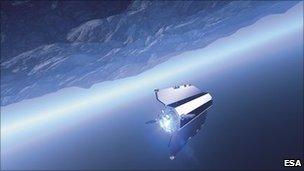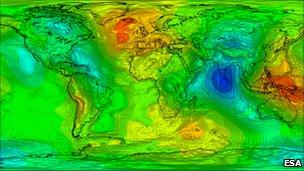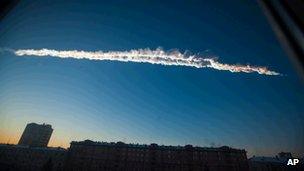Japan quake 'heard at edge of space'
- Published

Goce flies lower than any other scientific satellite
The great Tohoku earthquake in Japan two years ago was so big its effects were even felt at the edge of space.
Scientists say the Magnitude 9.0 tremor on 11 March 2011 sent a ripple of sound through the atmosphere that was picked up by the Goce satellite.
Its super-sensitive instrumentation was able to detect the disturbance as it passed through the thin wisps of air still present 255km above the Earth.
The observation is reported in the journal Geophysical Research Letters, external.
It has long been recognised that major quakes will generate very low-frequency acoustic waves, or infrasound - a type of deep rumble at frequencies below those discernible to the human ear. But no spacecraft in orbit has had the capability to record them, until now.
"We've looked for this signal before with other satellites and haven't seen it, and I think that's because you need an incredibly fine instrument," said Dr Rune Floberghagen from the European Space Agency (Esa).
"Goce's accelerometers are about a hundred times more sensitive than any previous instrumentation and we detected the acoustic wave not once, but twice - passing through it over the Pacific and over Europe," the mission manager told BBC News.
Goce's prime purpose is to map very subtle differences in the pull of gravity across the surface of the Earth caused by the uneven distribution of mass within the planet.
These variations produce almost imperceptible changes in the velocity of the satellite as it flies overhead and which it records with those high-precision accelerometers.
This gravity signal is very weak, however, and that means Goce must fly incredibly low to sense it - so low, in fact, that it actually drags through the top of the atmosphere.

Monday marks the second anniversary of the quake and tsunami that claimed more than 15,000 lives
It is these special circumstances that put the satellite in a position to detect the infrasonic disturbance on 11 March 2011.
The acoustic waves perturbed the density of air molecules and changed their speed. It was the faintest of winds at an altitude of 255km, but strong enough to be registered by Goce.
The Esa spacecraft encountered the signal as it passed over the Pacific some 30 minutes after the onset of the M9.0 event, and then again 25 minutes later as it moved across Europe.
Because of the way the accelerometers are arranged in Goce, it was possible to reconstruct the detection in three dimensions and so confidently trace the infrasound back to its source - the earthquake.

Goce's principal objective is to make maps of the variation in the pull of gravity across the Earth
"If you have a small ripple in density, it would be hard to conclude beyond any reasonable doubt that this was due to the earthquake," explained Dr Floberghagen. "But the fact that we have a very significant density perturbation, with the shape predicted by all the acoustic models, and the fact that we picked it up again on the other side of the Earth where you would expect to find it - that's perfect."
Scientists can already study earthquakes from space, in particular through the use of radar to map the deformation of the ground that results when faults rupture. But it remains to be seen how useful an acoustic sensor placed in a low-Earth orbit might be.
Tohoku was an exceptional event and this may explain why Goce, on this occasion, was able to pick it up.
Buoyed by their success, however, scientists on the mission are checking through the satellite's data to see if an infrasonic signal was also recorded when an asteroid entered the atmosphere over the Russian city of Chelyabinsk last month. The entry's infrasound signature was certainly evident to listening stations on the ground.

The Chelyabinsk meteor is known to have produced a big infrasound signal - but is it in Goce's data?
"Ever since we've flown this type of instrument - accelerometers - in space, people have been looking for the acoustic beat from earthquakes, because that could be used to understand the way tremors propagate not only through the Earth but through the Earth environment.
"We'll see; time will tell. But just the idea of an acoustic sensor in space is pretty cool," Dr Floberghagen told BBC News.
Goce itself is running low on fuel and is nearing the end of its mission.
Esa will lower its orbit in June to below 230km to try to obtain even finer detail on Earth's gravity field. The agency is then expected to command the satellite to come out of the sky and fall back to Earth in November.
Jonathan.Amos-INTERNET@bbc.co.uk and follow me on Twitter: @BBCAmos, external
- Published19 November 2012
- Published27 April 2012
- Published21 March 2011
- Published12 March 2012
- Published31 March 2011
- Published21 December 2010